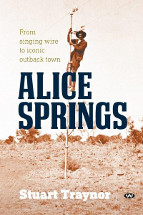Alice Springs: From singing wire to iconic outback town by Stuart Traynor

Wakefield Press, 2016. ISBN 9781743054499
(Age: Secondary) Recommended. Stuart Traynor spent 8 years
researching the history of central Australia for this book, and it
shows in the meticulous detailed recording of the lives spent in the
outback - from the explorers who tried to find a path through the
middle of Australia, to the linesmen who worked against the clock to
string a telegraph wire from Adelaide to Darwin, to the men, women
and children who carved out a life on that lonely frontier, not to
mention the Arrernte Aboriginal people whose lives were changed
forever. Traynor presents an impartial account that draws on
historical records to piece together the jigsaw puzzle of
interconnecting lives. He tells of the brutality and the massacres
within the context of the prevailing mindset of the time. Other
writers, e.g. Nettelbeck and Foster (2007) in their book In
the name of the law, have delved deeper to reveal a
darker heart of Australia, but while Traynor describes the trial of
William Willshire for the murder of Aboriginal men, it is but one
incident in the wider picture of the good men and bad who all
struggled to make a life in very demanding circumstances. However
his account of the stolen generation housed, if you can call it
that, in the appalling conditions of the 'Bungalow Half-caste
Institution' is not glossed over in any way and the story of the
desperate plea of the 16 year-old girl 'longing to have someone to
help her' escape the sexual demands of the Superintendent is
particularly poignant. In his postscript 'An iconic town' Traynor
writes that he hopes that we can learn from our past and weave
together 'a new life-giving culture' that can be shared by all.
The book is supplemented by a collection of historical photographs,
a detailed timeline 1860-1960, reference notes for each chapter, and
a bibliography and index. There are some maps at the beginning of
the book, showing the path of the submarine cable from England to
Australia, and the main towns on the cable line from Darwin to
Adelaide - my only quibble would be to wish for a more detailed map
showing the many smaller places described in the book. However the
book as a whole is an amazing feat of research and would be an
excellent reference for students studying this era in Australian
history.
Helen Eddy